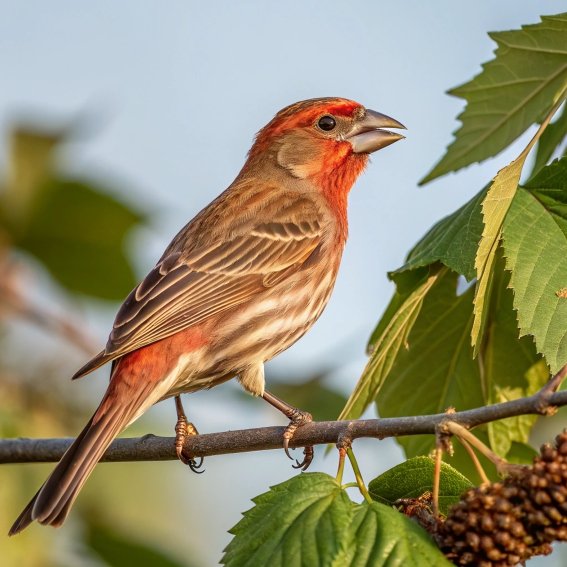Do Birds Pee? Exploring the Fascinating Urinary System and Unique Anatomy of Avian Species
One question that often puzzles both bird enthusiasts and casual observers alike is whether birds pee.
The answer to this seemingly simple query unveils a fascinating journey into the unique anatomy and physiology of our feathered friends.
Unlike mammals, birds have evolved a remarkably efficient waste management system that’s perfectly adapted to their airborne lifestyle.

Key Takeaways:
- Birds don’t pee like mammals: Instead of producing liquid urine, birds excrete a paste-like substance composed mainly of uric acid.
- The cloaca is a multifunctional organ: This single opening serves as the exit point for digestive, urinary, and reproductive systems in birds.
- Uric acid is the key: The white substance in bird droppings is primarily uric acid, the avian equivalent of urine.
- No bladder necessary: Birds lack a urinary bladder, an adaptation that helps keep them lightweight for flight.
- Highly efficient kidneys: Avian kidneys are specialized to produce concentrated waste, conserving water more effectively than mammalian kidneys.
- Evolutionary advantages: The avian excretory system offers benefits in water conservation and weight management, crucial for flight and survival in diverse habitats.
- Diet influences waste composition: A bird’s diet significantly affects the color and consistency of its droppings.
- Water conservation is crucial: Birds have developed various adaptations to conserve water, essential for survival in different environments.
- Flight shapes anatomy: The demands of flight have significantly influenced avian anatomy, including their excretory system.
- Waste as a defense mechanism: Some bird species have evolved to use their waste products as a defense against predators.
- Health indicator: The composition and appearance of bird droppings can provide valuable information about a bird’s health and diet.
- Environmental impact: Bird waste plays a significant role in various ecosystems, affecting soil composition and plant growth.
This comprehensive overview sets the stage for a deep dive into the fascinating world of avian physiology, offering insights into how these remarkable creatures have adapted to thrive in the skies and diverse environments across the globe.
The Avian Urinary System: A Unique Adaptation for Flight
Birds have evolved a remarkable urinary system that differs significantly from mammals. Unlike humans and other mammals, birds don’t produce liquid urine.
Instead, their bodies have adapted to excrete waste in a more efficient and lightweight manner.
This adaptation is crucial for flight, as it allows birds to maintain their agility in the air without the burden of carrying excess liquid.
The avian urinary system is closely integrated with their digestive system, resulting in a combined waste product that is expelled through a single opening called the cloaca.
This efficient system helps birds conserve water and maintain their lightweight bodies, which is essential for their aerial lifestyle.
The unique structure of the avian urinary system is a testament to the incredible adaptations that have allowed birds to conquer the skies and thrive in diverse environments across the globe.
The Cloaca: A Multifunctional Organ in Birds

The cloaca is a remarkable organ in birds that serves multiple functions. This single opening is the endpoint for the digestive, urinary, and reproductive systems.
In birds, urine produced by the kidneys is directed into the cloaca, where it mixes with feces from the digestive tract. The cloaca acts as a temporary storage chamber for both urine and feces before they are expelled together.
This multifunctional organ is an evolutionary adaptation that streamlines the bird’s anatomy, making it more efficient for flight.
The cloaca also plays a crucial role in reproduction, serving as the exit point for eggs in females and sperm in males.
During mating, birds perform a “cloacal kiss,” where their cloacas briefly touch to transfer sperm.
This unique organ demonstrates how birds have evolved to maximize efficiency in their bodily functions, combining multiple systems into a single, versatile structure.
Uric Acid: The White Substance in Bird Droppings
The white paste-like substance often seen in bird droppings is not actually urine in the traditional sense. Instead, it is primarily composed of uric acid, which is the avian equivalent of urine.
Birds’ livers convert nitrogen waste into uric acid, which is then excreted through the cloaca along with feces. This white, paste-like substance is highly concentrated and contains very little water, allowing birds to conserve moisture effectively.
The production of uric acid instead of urea (found in mammalian urine) is an important adaptation for birds, as it requires less water to eliminate nitrogen waste from their bodies.
This efficient waste removal system helps birds maintain their lightweight bodies for flight and survive in environments where water may be scarce.
The distinctive white color of uric acid in bird droppings is a visual reminder of the unique ways birds have adapted their physiology to meet the demands of their aerial lifestyle.
The Absence of a Bladder: How Birds Manage Waste

Unlike mammals, birds do not have a urinary bladder to store liquid waste. This absence is another adaptation that contributes to their lightweight bodies, essential for efficient flight.
Instead of storing urine, birds’ kidneys filter waste and send uric acid directly to the cloaca.
The lack of a bladder means that birds can eliminate waste more frequently and in smaller amounts, which is advantageous for flying creatures.
This system allows birds to maintain a constant, lightweight body mass without the need to carry around excess liquid waste.
The efficient waste management system in birds is a prime example of how evolution has shaped their anatomy to optimize flight performance.
By eliminating the need for a bladder, birds can dedicate more of their body mass to flight muscles and other essential structures, making them incredibly well-adapted for life in the air.
Kidney Function in Birds: Efficient Waste Processing
Bird kidneys play a crucial role in their unique waste management system. These organs are highly efficient at filtering blood and producing concentrated waste in the form of uric acid.
Avian kidneys have a specialized structure called renal lobules, which allow for more effective urine concentration than mammalian kidneys.
This adaptation enables birds to conserve water more efficiently, which is particularly important for species that live in arid environments or migrate long distances.
The kidneys work in tandem with the liver to convert nitrogen waste into uric acid, which requires less water to excrete than urea.
This process not only helps birds maintain proper hydration but also contributes to their ability to maintain a consistent body weight for flight.
The remarkable efficiency of bird kidneys demonstrates the intricate ways in which avian anatomy has evolved to meet the unique challenges of flight and diverse habitats.
Evolutionary Advantages of the Avian Excretory System
The avian excretory system offers several evolutionary advantages that have contributed to the success of birds as a class of animals.
By eliminating liquid urine and producing concentrated uric acid instead, birds can conserve water more effectively than mammals. This adaptation is particularly beneficial for species that live in dry environments or undertake long migrations.
The lightweight waste management system also allows birds to maintain their agility in flight, as they don’t need to carry the extra weight of liquid urine.
Additionally, the combined excretion of uric acid and feces through the cloaca is more energy-efficient, as it requires less metabolic effort than separate systems for urine and feces.
These adaptations have enabled birds to colonize a wide range of habitats across the globe, from deserts to polar regions, demonstrating the remarkable success of their unique excretory system in various environmental conditions.
Comparing Avian and Mammalian Urinary Systems
The differences between avian and mammalian urinary systems highlight the diverse ways animals have adapted to their environments.
While mammals produce liquid urine containing urea and store it in a bladder, birds excrete uric acid without the need for a bladder.
Mammalian kidneys produce dilute urine that requires significant water content, whereas bird kidneys create a concentrated waste product. This difference in waste concentration allows birds to conserve water more effectively than mammals.
The mammalian system of separate urinary and fecal excretion contrasts with the bird’s combined waste elimination through the cloaca.
These distinctions reflect the different evolutionary pressures faced by birds and mammals, with birds adapting to the demands of flight and often living in environments where water conservation is crucial.
The comparison between these systems demonstrates the remarkable diversity of solutions that evolution has produced to address similar biological challenges across different animal groups.
The Role of Diet in Avian Waste Composition
A bird’s diet plays a significant role in the composition of its waste. Different food sources can affect the color, consistency, and chemical makeup of bird droppings.
For example, birds that primarily eat seeds may produce droppings with a different appearance compared to those of insectivorous or frugivorous species.
The uric acid content in bird waste can vary depending on the protein content of their diet. Birds with high-protein diets, such as raptors, often produce whiter droppings due to higher uric acid concentrations.
Conversely, birds that consume more plant matter may have droppings with a greenish tint.
The water content of a bird’s diet also influences waste consistency, with fruit-eating birds often producing more liquid droppings.
Understanding these variations in waste composition can provide valuable insights into a bird’s diet and overall health.
Researchers and bird enthusiasts often use this information to study wild bird populations and assess the nutritional status of captive birds.
Adaptations for Water Conservation in Birds
Birds have developed various adaptations to conserve water, which is crucial for their survival, especially in arid environments or during long flights.
The production of uric acid instead of urea is one such adaptation, as it requires less water to excrete. Many bird species have also evolved specialized nasal glands that help them excrete excess salt without losing significant amounts of water.
This is particularly important for seabirds that ingest large quantities of saltwater.
Some birds, like the sandgrouse, have specially adapted feathers that can absorb and transport water to their chicks in desert environments.
The ability to concentrate urine in the kidneys and reabsorb water in the cloaca further enhances water conservation.
These adaptations allow birds to maintain proper hydration levels even in challenging conditions, contributing to their success in diverse habitats around the world.
The Impact of Flight on Avian Anatomy
The demands of flight have significantly shaped avian anatomy, including their excretory system. Birds have evolved hollow bones and efficient respiratory systems to reduce weight and increase oxygen uptake, both crucial for flight.
The absence of a bladder and the production of concentrated uric acid contribute to maintaining a lightweight body.
The positioning of the kidneys and cloaca in the bird’s body is also optimized for flight, helping to maintain balance in the air.
The efficient excretory system allows birds to eliminate waste quickly without carrying excess weight, which is essential for maintaining agility during flight.
Even the shape and size of birds’ digestive organs have been influenced by the need to remain lightweight for flight.
These anatomical adaptations demonstrate how the ability to fly has been a driving force in shaping the unique physiology of birds, including their waste management system.
Unusual Adaptations: Birds That Use Waste for Defense
Some bird species have developed remarkable adaptations that involve using their waste for defense. The hoatzin, a South American bird, has a unique digestive system that ferments vegetation in its crop.
This process produces a foul-smelling odor that deters predators. When threatened, hoatzin chicks can regurgitate this malodorous substance as a defense mechanism.
Another example is the fulmar, a seabird that can project a foul-smelling oil from its stomach at potential predators.
This oil, which is part of their digestive process, can mat the feathers of other birds, potentially leading to their death.
Some species of herons have been observed defecating on their own legs, using the evaporative cooling effect to regulate their body temperature in hot environments.
These unusual adaptations showcase the diverse ways in which birds have evolved to use their waste products for survival, demonstrating the remarkable ingenuity of nature in developing defense mechanisms and thermoregulation strategies.
The Importance of Proper Waste Management in Avian Health
Proper waste management is crucial for maintaining avian health, both in wild and captive bird populations.
The composition and appearance of bird droppings can provide valuable information about a bird’s diet, hydration status, and overall health.
Abnormalities in waste production or appearance can be early indicators of various health issues, including digestive problems, infections, or metabolic disorders.
In captive birds, monitoring waste output and composition is an essential part of health assessment.
For wild birds, the study of droppings can offer insights into population health, diet changes, and environmental impacts.
Proper sanitation in aviaries and bird habitats is crucial to prevent the spread of diseases, as many pathogens can be transmitted through fecal matter.
Understanding the normal waste production patterns of different bird species is important for both veterinary care and conservation efforts, helping to ensure the well-being of these remarkable creatures in various settings.
Avian Waste and Its Environmental Impact
Bird waste plays a significant role in various ecosystems. In some environments, particularly islands or coastal areas with large seabird colonies, bird droppings (guano) can substantially impact soil composition and plant growth.
Guano is rich in nitrogen, phosphorus, and other nutrients, making it a valuable natural fertilizer.
This nutrient input can lead to changes in local vegetation and even affect marine ecosystems near bird colonies.
However, in urban environments, large accumulations of bird droppings can pose challenges, potentially causing damage to buildings and monuments.
Bird waste can also be a vector for certain diseases, highlighting the importance of proper management in areas where birds and humans coexist closely.
On a positive note, studying bird droppings can provide valuable data for ecological research, offering insights into bird diets, migration patterns, and environmental changes.
The environmental impact of avian waste demonstrates the complex interactions between birds and their habitats, underscoring the interconnectedness of ecosystems.
Frequently Asked Questions
Do birds urinate like mammals?
No, birds do not urinate in the same way as mammals. Instead of producing liquid urine, birds excrete a paste-like substance composed mainly of uric acid, which is mixed with feces and expelled through the cloaca.
Why is bird poop white?
The white color in bird droppings comes from uric acid, which is the avian equivalent of urine. This white, paste-like substance is how birds eliminate nitrogen waste from their bodies.
Do all birds have the same waste elimination system?
While most birds share a similar waste elimination system involving the cloaca and uric acid production, there are some variations among species. For example, ostriches are unique in that they can separate liquid and solid waste to some extent.
How often do birds eliminate waste?
The frequency of waste elimination in birds varies depending on the species, diet, and size. Many small birds may defecate every 15-20 minutes, while larger birds might do so less frequently.
Can bird droppings be harmful to humans?
While bird droppings are generally not directly harmful, they can sometimes carry pathogens that may pose health risks to humans. It’s always advisable to practice good hygiene when dealing with bird waste.

Hello, I’m Emily Price, the founder of Birds Affection. As a passionate bird enthusiast and spiritual seeker, I’ve always been fascinated by the symbolic meanings and mystical connections between birds and our lives. On this website, I share my knowledge and insights on the spiritual significance of various bird species, exploring their roles as messengers, guides, and teachers. Through my writing, I aim to inspire and educate others on the profound wisdom and beauty that birds bring to our world. Join me on this journey as we delve into the enchanting realm of bird symbolism and discover the hidden meanings behind these magnificent creatures.







